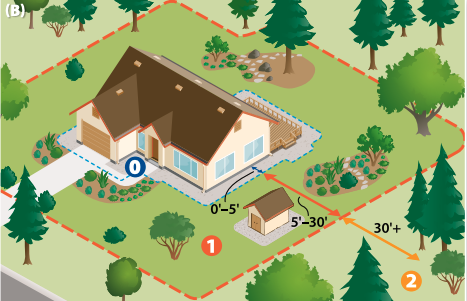Firewise Landscaping: Make your home safer
“Fire Season” will soon be here. It seems paradoxical, but this year’s drought-ending rains actually increase the threat of wildfire. This is because the lush vegetation made possible by the series of “atmospheric rivers” will soon dry out and, if not managed properly, will become fuel. Although wildfires were once confined to woodland areas, homes in suburban areas are increasingly vulnerable to devastation. The good news is that there are things you can do to improve the odds of your home surviving a wildfire. The time to act is now and here’s how:
Create “defensible space” around your home
“Defensible space” means that the areas around your house and other structures have been designed and maintained to reduce the risk of fire. This gives fire fighters the best chance of defending your home. Visualize your house at the center of three concentric rings with each ring representing a “zone” of defensible space.
Zones

Zone #0: the area immediately next to your house, extending outward five feet.
Because most homes are destroyed when embers ignite flammable items on or near the structure, this area should be kept free of anything combustible. Check the roof, gutters, nooks and crannies around the house and under decks for dry leaves and pine needles. Relocate your woodpile away from your house, stow brooms and flammable lawn furniture somewhere safe and replace natural fiber doormats with non-flammable alternatives.
All plants—even green ones—are flammable so relocate any shrubs next to your house to suitable areas farther away. Replace wood and other flammable mulches with decorative rocks and crushed stone. Any plants in this area should be widely spaced, low-growing, non-woody and herbaceous. Succulents can be a good option.
Zone #1: the next circle moving outward, between 5 and 30 feet from the home. Key words for this space are “lean, clean, and green.” “Lean” means a limited amount of vegetation with adequate spaces in between to prevent flames from climbing or “laddering.” “Clean” means the area is kept free of dead, dry plant debris. “Green” means plants in this zone receive adequate irrigation, especially during fire season. You can increase the water holding capacity of the soil by incorporating organic soil amendments before planting and by using rock mulches instead of highly combustible bark mulches.
Zone #2: is the outermost circle, the area 30 to 100 feet away from your home. Here, the objective is to minimize fuel that would allow fire to spread inward toward structures and to inhibit flames from moving upward into the crowns of trees.
Preventive action includes removal of dead or dying trees, dead branches and piles of dry twigs and bark. Thin trees so that branches are separated by at least 10 feet. For taller trees, prune branches so the lowest are 10 feet from the ground. (Note: If your property does not extend this far, work with your neighbors to come up with a plan for mutual safety.)
Which plants to plant?
No plants are “fire-proof” but some plants are inherently more fire-resistant than others. These types of plants store water in their leaves and stems and when subjected to fire conditions, can reduce the intensity with which a fire spreads by acting as “heat sinks.” Overall, these plants tend to have a relatively low volume of total vegetation and do well with limited watering. Many plants native to California meet fire resistant criteria. Plants with silver or gray leaves (except for highly ignitable, fragrant sages) are less flammable due to their high mineral content.
When searching for less flammable plants, look for these characteristics:
| Less Flammable | More Flammable |
| Deciduous | Evergreen |
| Slower growing | Fast growing |
| Deep rooted | Shallow rooted |
| Low amount of litter | High amount of litter |
| Moist, flexible leaves | Stiff, leathery leaves |
| Thick leaves | Fine, thin, needly leaves |
| Thin, watery sap | Thick, sticky, resinous sap |
| No/Low fragrance | Highly aromatic |
| Plants without hair (cilia) | "Hairy" leaves and stems |
| Loose, open branching | Dense, compact shape |
Resources
Wildfire safety presentation covering zones and planting recommendations:
For more on choosing fire-resistant plants, check the UC Cooperative Extension website at: https://ucanr.edu/sites/fire/Prepare/Landscaping/Plant_choice/
For more on fires, defensible space and preparedness, check out these websites:
What’s Behind California’s Surge of Large Fires? - https://earthobservatory.nasa.gov/images/148908/whats-behind-californias-surge-of-large-fires
Fire in California: Defensible Space:
https://ucanr.edu/sites/fire/Prepare/Landscaping/DefensibleSpace/
Wildfires: Protecting Our Homes-and Our Forests:
https://sonomasun.com/2021/06/22/wildfires-protecting-our-homes-and-our-forests/

